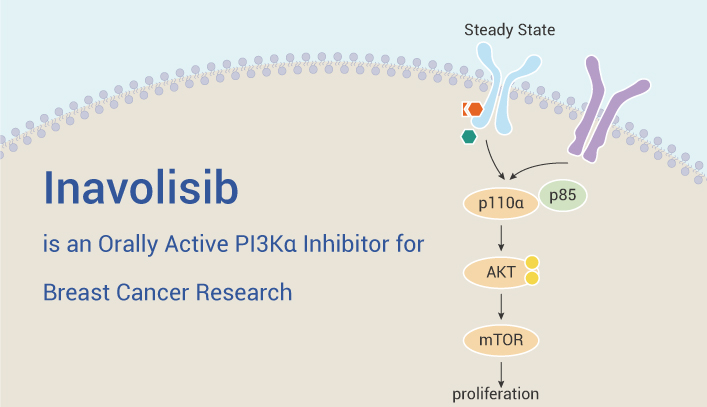Phosphoinositide 3-kinases (PI3Ks), also called phosphatidylinositol 3-kinases, are a family of related intracellular signal transducer enzymes. Class I PI3K enzymes consist of four distinct catalytic isoforms, PI3Kα, PI3Kβ, PI3Kδ and PI3Kγ. The pathway, with oncogene PIK3CA and tumor suppressor gene PTEN, is implicated in the sensitivity of cancer tumors to insulin and IGF1, and in calorie restriction. Therefore, the PI3K pathway plays an important role in many biological processes. Such as cell cycle progression, cell growth, survival, actin rearrangement and migration, and intracellular vesicular transport.
PI3Kα, a critical lipid kinase, has two subunits, catalytic (p110) and inhibitory (p85). There are 5 species: p85α, p55α and p50α, p85β and p55γ. Dysregulation of the PI3Kα signaling pathway plays an important role in tumorigenesis and drug resistance. In unstimulated cells, the p110α protein is kept in an inactive and stable cytosolic configuration. De-inhibition occurs upon recruitment of the enzyme complex to phosphorylated RTKs at the plasma membrane, as well as upon binding to the small GTPase RAS. The resulting conformational changes in PI3Kα lead to membrane recruitment and catalytic activity towards its lipid substrate PI(4,5)P2.
Inavolisib (GDC-0077 ) is a potent, selective and orally active inhibitor of PI3Kα.

GDC-0077 exerts its activity by binding to the ATP binding site of PI3K. Therefore, GDC-0077 can inhibit the phosphorylation of PIP2 to PIP3. Importantly, GDC-0077 is more selective for mutant versus wild-type PI3Kα. Specifically, GDC-0077 (RG6114) is >300-fold more selective for PI3Kα over the other class I PI3K isoforms (β, δ, and γ) and >2000-fold more selective over PIK family members. Meanwhile, GDC-0077 induces inhibition of cell proliferation, and increased apoptosis in human PIK3CA-mutant breast cancer cell lines. What’s more, GDC-0077 results in tumor regressions and induction of apoptosis in patient-derived PIK3CA-mutant breast cancer xenograft models.
All in all, GDC-0077 is a potent and orally active inhibitor of PI3Kα that has potential for the research of breast cancer.
References:
[1] Vanhaesebroeck B, et, al. Cancer Discov. 2022 Jan;12(1):20-22.
[2] R Hong, et, al. Cancer Res. 2018; 78 (4_Supplement): PD4-14.